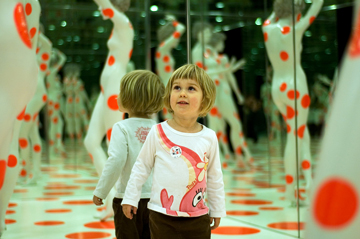As an institution that exhibits contemporary, site-specific installation art through a fully supported artist residency program, we only ever get to experience exhibitions for a few months and then they go away—in some cases, forever. And once they do, the galleries are de-installed, painted cleanly, and left to wait for the next artist to arrive and begin again the process of creating a new space with new meaning. The Museum’s Education Department develops programs that help to define and differentiate the very unique experiences that impermanent installation art and artists provide and to create dialogue — beyond the museum visit — about human behavior and the physical world.
When we talk about artwork at the Mattress Factory, we attempt to make contemporary art and artists real and relevant. Through discussion, we make connections between what is in the gallery and what is in one’s life. The process of seeing and noticing extends outside of “art” spaces and into everyday situations and scenarios. For children particularly, the importance of facts, figures, and art historical references play second (or third or fourth) fiddle to how something makes us feel. Is it fun, sad, or stressful? Is it familiar, scary, or silly? Is it beautiful or ugly or maybe both? Is it even art at all?
By asking why something makes us feel a certain way, we get to point out all of the important decisions that artists make in their creative process. We try to help visitors grapple with the notion that the environments that they stand in, absorb, love or hate, are most likely fleeting and exist because an artist has made very specific choices. By critically examining how a space is configured and what physical characteristics play a roll in our mental mapping and interpretation of it, we get to understand the whole work differently. Ultimately (or hopefully), by carefully pointing to moments of change or alteration within the gallery we empower visitors to then find these gestures everywhere in their lives.
How do we facilitate discussions of installation art that will create lasting impressions on the way visitors interpret their environments once they leave the gallery? Furthermore, how do we convey these messages and lessons to those unable to visit the Museum at all?
For some time, the Mattress Factory has offered Artist-School partnerships. These programs provide funding and support for ten to twenty day artist residencies in schools throughout Southwestern Pennsylvania. Artists are expected to convey installation art concepts while fostering individual student-directed projects to be exhibited on school grounds. Additionally, schools are given funding for a field trip to the museum. Though these programs have been very successful, they still pose challenges and are only appropriate for certain teachers and students.
The Mattress Factory’s Education Department is now working on a project called “The Space I’m In,” which will be a resource for educators to use off-site with elements—created by artists—that support the same types of conversations fostered during education programs and tours at the museum. It endeavors to establish a framework that challenges users to reflect upon the implications of their habitats and thinking processes, to better understand spatial characteristics, to consider the phenomena of our world and then to think critically about, manipulate, and experiment with and in their familiar spaces. The museum began thinking of the project as another way for professional artists to directly inform in-school outreach—to seriously find ways of taking an installation art experience to spaces and audiences that may not otherwise have opportunities for direct exposure to this type of work.
To start, we approached a small group of international artists and asked them to consider ways that they could help teachers and students re-interpret their surroundings. Each artist was selected based on their work within the realm of specific phenomena such as light, sound, memory and spatial relationships. What we’ve come up with will be a grouping of individual, portable elements paired with lessons, topics for discussion, and resource materials. We are now in the process of working with regional teachers who can inform the work we’ve done and help pinpoint areas of need within school environments.
The expectations of “The Space I’m In” go well beyond action and experience. An integral part of this project will be the accumulative documentation of its users in a communal space (i.e. a website)—an ongoing, recorded collaboration among educators across the country (or world) as they use and redefine this resource to its limits. This project has no foreseeable conclusion. It is indefinitely flexible and will be characterized by those who use it—just like everything else at the Mattress Factory.
Our hope with this project is to not only contextualize installation art within the history of art and provide needed aids for teaching this genre to students, but to also create discussions on how seeing art can change the way we see everything else. Art can move us to the point of wonder and awe, but it can also pose questions that may inform a mindset that the man-made world (art included) has been created to illicit certain responses, feelings, and routes through it. To precisely pinpoint how individuals can or should experience art is completely impossible. Instead, our only option is to create a system (through education, communications, and archiving) that allows for all possible iterations and gives users the space and voice to share.
Elizabeth Keller is Director of Education at the Mattress Factory in Pittsburgh, PA.